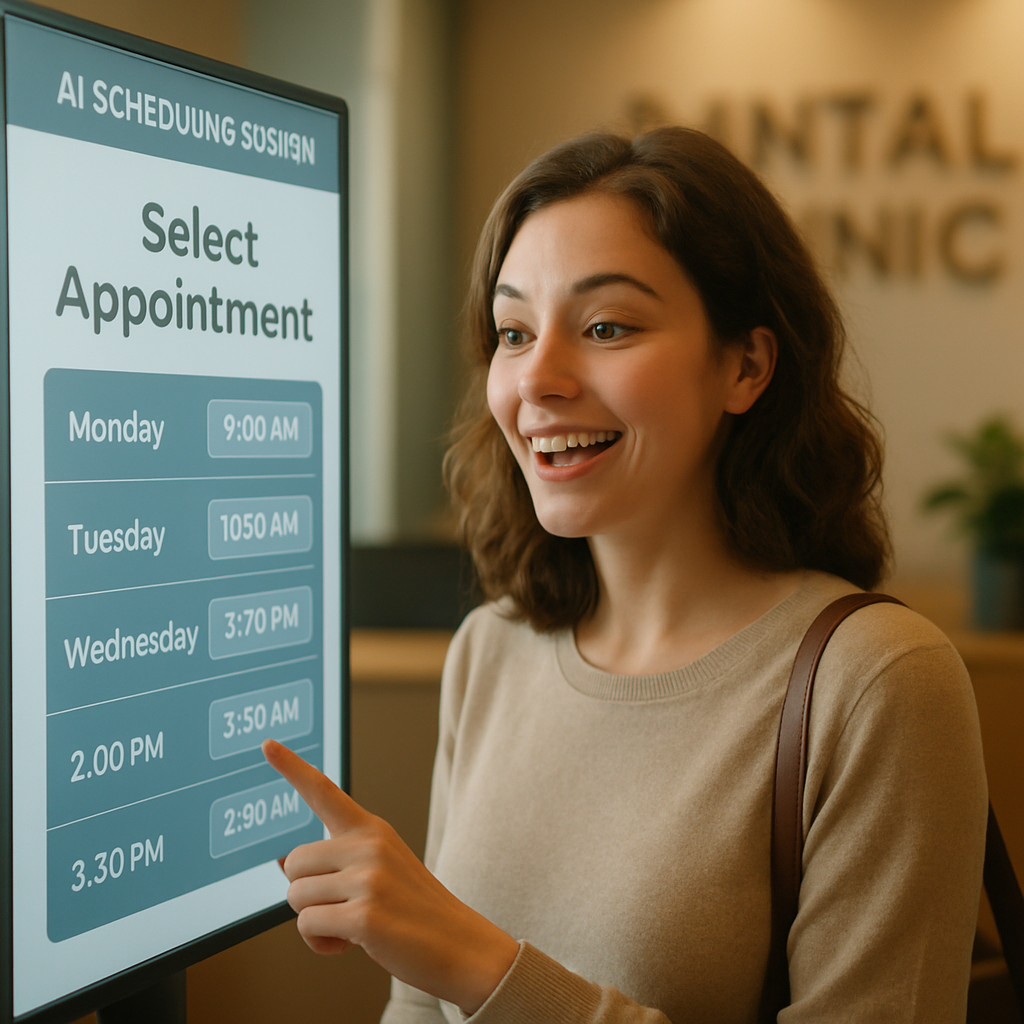December 26, 2025
12 min
Discover how to balance data privacy with effective analytics in dental practices while ensuring compliance and building patient trust.
August 6, 2025
10 minutes
AI conversational marketing assistants are transforming dental practices by automating patient engagement, improving scheduling, boosting retention, and streamlining front-desk operations.

Technology infiltrates all professions. Dentists aren’t immune. When we talk about dental marketing, the technologies doing the real work are now quietly making yesterday’s strategies look quaint. AI, in particular, isn’t just automating what dental staff used to do—it’s transforming what’s possible through AI-driven marketing intelligence for dentists. At the center of this shift: conversational marketing assistants—tools that aren’t about buzzwords, but about the gritty business of talking with patients, automating tedious processes, and, if you use them well, helping your practice outgrow its competitors.
What They Are
These aren’t your average web widgets. AI conversational assistants are software built to converse. They use language models and algorithms to interact with patients as if they were real receptionists (or at least get close enough that patients feel heard and cared for). Powered by advances in natural language processing and machine learning, these systems adapt, reason, and—unlike static scripts—respond in real-time, which means that for most patient questions, just waiting on human help becomes an anachronism.
What Sets Them Apart
1. Automation: Imagine redeploying the front desk’s efforts. AI-driven assistants can book appointments, nudge patients with reminders, and handle routine questions—often better than overstretched staff. Mistakes drop, and the patient pipeline never sleeps. Tools like SmartBot360 essentially act as a digital employee that works every hour, on every inquiry, with reliable consistency.
2. Instantaneity – The Real-Time Advantage: The alchemy here is speed. AI assistants reply immediately. Instead of an overgrown voicemail or endless email lag, patients get answers now. Simultaneous sessions mean you can handle dozens of requests at once—no one has to listen to hold music again.
3. Personal Touch at Scale: What matters is context. If a patient chatted last week about whitening, the AI brings it up again, personalizes reminders, or flags relevant specials. The more it interacts, the more it learns, tuning recommendations and advice instead of sending scattershot responses.
4. As Flexible as Practices Demand: Reach matters. These digital assistants can be embedded in websites, show up in mobile apps, chat via WhatsApp or Facebook Messenger, and switch languages as needed. Branding and workflows bend to your practice, not the other way around.
5. Learning Loops: Because all interactions are data, these systems turn conversations into insights. Over time, you’ll spot patterns in patient questions and behavior that can inform not just marketing, but clinical strategy.
1. Patients Finally Get Heard: People don’t want to wait. Tools like chatbots give instant, context-sensitive responses. Automated reminders remove slipshod follow-up. Patients don’t just get information—they feel like the office knows them, even at 2 am.
2. Data Moves from Gut Feeling to Numbers: AI handles the grunt work of collecting (and slicing through) vast chunks of patient data. Spot trends. Forecast appointments. Recognize the most common pre-care questions before the receptionist has to.
3. Engagement and Loyalty Multiply: Tailored messages and nudges keep patients showing up—and coming back. Engagement isn’t just about attention; it’s about patients who trust your responsiveness and feel remembered.
4. Time (and Payroll) Regained: The economics matter. AI slices the repetitive task list at the front desk, so people can actually focus on what matters—like care and complex conversations. Fewer hours on logistics means more for dentistry and a leaner bottom line.
1) Dentistry-Focused Chatbots: Products like SmartBot360 are live 24/7. They handle FAQs, scheduling, and eligibility questions. Patients stay informed and engaged—no language barriers, no after-hours radio silence.
2) Smarter Scheduling: Take Voice Scheduling Assistant, for example: it links directly with your calendar, transcribes appointment requests, sends reminders, and shrinks no-show rates. It’s not just a digital calendar, but an active gatekeeper for your time.
3) Richer, Responsive Patient Communication Platforms: AI-powered communications personalize reminders and recommendations. Instead of endless generic newsletters, patients get pointed, timely notes—helping them feel more connected and less like a number.

1. Map Your Friction Points: Pinpoint inefficiencies—lost confirmations, slow intake, scattered communications—that AI could solve first.
2. Pick Precisely-Matched Tools: Don’t install tech for tech’s sake. If after-hours communication tanks, a chatbot is step one. Struggling with missed bookings? Scheduling automation is a faster payoff. If images drive diagnoses, look at Overjet or its peers.
3. Integration Is as Much Social as Technical: IT must ensure the gears mesh: practice management software, health records, and calendar. But the best rollouts engage the human side by prioritizing privacy, complying with legal requirements (HIPAA, etc.), and making the tech as invisible as possible.
4. Tactical Tech Steps:
Check data compatibility before you invest.
Be ruthless about data privacy.
Leverage cloud-based options for scale—don’t bet on static, install-it-and-forget-it setups.
5. Train Relentlessly: Push staff to treat AI as an ally, not a rival. Structure onboarding so questions and curiosity get as much attention as mandates. Continuous learning creates champions, not reluctant adopters.
6. Iterate and Improve—the Silicon Valley Way: Regularly review the measurable effects. KPIs and patient feedback are your north star. Find the cracks, update, and keep asking: “Is this making patient (and staff) lives easier?”
7. Feedback Loops That Work:
- Track patient engagement every month—are communications actually getting read and acted on?
- Stay current on product updates, patching gaps promptly.
- Gather staff input routinely—friction surfaces here first.
Many dentists operate half-blind when it comes to marketing ROI. ConvertLens offers a dashboard of clarity, showing not just where leads come from, but which ones convert—and what they cost. The platform automates follow-up, sorts leads, and lets you focus your spending on campaigns that get results.
1. Interactive Dashboard: At a glance, see real metrics that let you double down—or pivot—on marketing dollars well spent.
2. CRM for Lead Intelligence: Capture, score, and move leads forward automatically with dental lead tracking CRM. That’s efficiency most front desks never reach with sticky notes or spreadsheets.
3. Hard Data on ROI: The best ideas in marketing are quantitative. Know—don’t guess—which campaigns pay for themselves.
1. Integrates Smoothly: If you already have a practice management system, ConvertLens slips in without drama.
2. Adapts to You: Workflows bend around how your practice actually operates, rather than forcing more process onto your day.
3. Sharpens Patient Conversion: By using data as a compass, you see where and how prospects become loyal patients—and can act accordingly.
Thousands of dental practices in different countries have used ConvertLens to pull clarity from chaos—optimizing budgets, improving conversations, and seeing the direct line from interest to new patient growth. Transparency builds momentum; metrics guide smarter choices.
Technology by itself rarely saves the day. Success comes from pairing the right tech to clearly defined goals, with a bias toward practical results over wishful thinking.
1. Don’t Skip Goal-Setting: Whether you want more leads, higher patient engagement, or increased local visibility, make sure every AI choice has your specific goal as its north star. That’s the only way to keep the tech in service of what you truly need.
2. Emphasize Engagement: Outperformers focus on messaging that’s personal—using AI to maintain a live connection, not just send generic broadcasts. Chatbots and automated reminders are engagement engines—used wisely, they create loyal patients.
3. Fine-Tune Relentlessly: Top practices measure everything. They don’t just launch campaigns or automations—they test, learn from the numbers, and double down on what works. Continuous improvement is how AI becomes a force multiplier rather than just a cost line item.
Complacency is the enemy. The world of dental marketing shifts. Stay plugged into what’s new, experiment without fear, and treat every win and loss as a data point to adjust course. That’s what keeps innovative practices competitive.
Much of what works today will only accelerate. Algorithms improve weekly, and what seems cutting-edge now will look basic in a year. The future is speed, accuracy, and more patient-specific insight—paired with the judgment and artistry of actual dentists.
1. We’re Just Getting Started with Diagnostics: AI already matches or surpasses humans in imaging-based detection—some studies put caries and periodontal detection at 95% accuracy. The next step: continuous learning models that adapt in real clinical environments and flag things that used to slip by.
2. From Predictive Analytics to Custom Care Paths: Where this goes: treatments tailored to the risk factors, history, and real-world needs of each patient. As predictive models get better, interventions get more timely, less generic, and more effective.
3. Imaging That Visualizes What Was Once Invisible: Advancements in real-time 3D visualization and collaborative planning software mean dentists (and patients) see every nuance in a mouth’s shape or condition—while AI recommends next steps.
4. Administrative Headaches Fade: Why does any dentist (or patient) need to fill out five forms and confirmation emails for each visit? AI is already automating scheduling, eligibility checks, and claims. Expect more of the tedium to vanish.
5. Conversational Interfaces Get Smarter: The next wave of chatbots talks less like scripts and more like people: context-aware, multilingual, and unstoppable on any platform your patients use.
6. New Ethical Frontiers: Patient data is sacred. The profession will grapple with privacy trade-offs and regulatory demands. AI adoption will race ahead, but practices keeping ethics front and center will build deeper, long-term patient trust.
What’s clear: these aren’t fads. The innovations coming aren’t about cost-cutting but about elevating not just how care is marketed but how it’s done.
What is an AI conversational marketing assistant?
An AI conversational marketing assistant is a software tool that uses artificial intelligence to engage with customers through conversational interfaces, such as chatbots or voice assistants. They help businesses automate customer interactions, provide support, and drive sales through personalized conversations.
How do AI conversational marketing assistants improve customer engagement?
These assistants can provide immediate responses to customer inquiries, personalize interactions based on user data, and engage with customers across multiple channels. This enhances the user experience and keeps customers satisfied.
Can AI conversational marketing assistants handle complex queries?
Yes, many AI conversational marketing assistants are designed to handle complex queries using natural language processing (NLP). They can understand context, recognize intent, and provide accurate responses or escalate issues to human agents when necessary.
What industries benefit most from AI conversational marketing assistants?
Industries such as e-commerce, healthcare, finance, and travel benefit significantly from AI conversational marketing assistants. They help streamline customer service, improve sales processes, and enhance overall customer satisfaction in these sectors.
Are AI conversational marketing assistants cost-effective?
Implementing AI conversational marketing assistants can reduce customer service costs by automating routine inquiries and allowing human agents to focus on more complex issues. This can lead to significant savings over time.
How can businesses integrate AI conversational marketing assistants into their existing systems?
Businesses can integrate AI conversational marketing assistants through APIs or by using platforms that support chatbot development. Many solutions offer ready-to-use templates and integrations with popular CRM and communication tools.
Just as no startup survives by ignoring software, no dental practice will thrive by pretending AI is a side issue. AI conversational marketing assistants are already shaping how patients find, choose, and interact with dental care. For dentists willing to explore, experiment, and adapt, the rewards are greater engagement, higher retention, and less administrative grind. The choice is stark: adapt and lead, or get left behind. The tools are here. It’s your move.



Sign Up Now & Someone from Our Team Will Be in Touch Shortly!
Use the form below to send us a message, and we’ll get back to you as soon as we can.